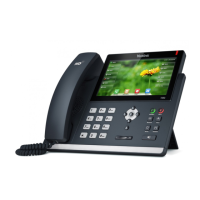Administrator’s Guide for SIP-T2 Series/T19(P) E2/T4 Series/CP860 IP Phones
648
addressing mode, IPv6 addressing mode, as well as an IPv4&IPv6 dual stack
addressing mode. IPv4 uses a 32-bit address, consisting of four groups of three decimal
digits separated by dots; for example, 192.168.1.100. IPv6 uses a 128-bit address,
consisting of eight groups of four hexadecimal digits separated by colons; for example,
2026:1234:1:1:215:65ff:fe1f:caa.
VoIP network based on IPv6 can provide end-to-end security capabilities, enhanced
Quality of Service (QoS), a set of service requirements to deliver performance
guarantee while transporting traffic over the network.
If you configure the network settings on the phone for an IPv6 network, you can set up
an IP address for the phone either by using SLAAC (ICMPv6), DHCPv6 or by manually
entering an IP address. Ensure that your network environment supports IPv6. Contact
your ISP for more information.
IPv6 Address Assignment Method
Supported IPv6 address assignment methods:
Manual Assignment: An IPv6 address and other configuration parameters (e.g.,
DNS server) for the IP phone can be statically configured by an administrator.
Stateless Address Autoconfiguration (SLAAC)/ ICMPv6: SLAAC is one of the most
convenient methods to assign IP addresses to IPv6 nodes. SLAAC requires no
manual configuration of the IP phone, minimal (if any) configuration of routers, and
no additional servers. To use IPv6 SLAAC, the IP phone must be connected to a
network with at least one IPv6 router connected. This router is configured by the
network administrator and sends out Router Advertisement announcements onto
the link. These announcements can allow the on-link connected IP phone to
configure itself with IPv6 address, as specified in RFC 4862.
Stateful DHCPv6: The Dynamic Host Configuration Protocol for IPv6 (DHCPv6) has
been standardized by the IETF through RFC 3315. DHCPv6 enables DHCP servers to
pass configuration parameters such as IPv6 network addresses to IPv6 nodes. It
offers the capability of automatic allocation of reusable network addresses and
additional configuration flexibility. This protocol is a stateful counterpart to “IPv6
Stateless Address Autoconfiguration” (RFC 2462), and can be used separately or
concurrently with the latter to obtain configuration parameters.
How the IP phone obtains the IPv6 address and network settings?
The following table lists where the IP phone obtains the IPv6 address and other network
settings:
How the IP phone obtains the IPv6 address and network
settings?
You have to manually configure the static IPv6 address
and other network settings.

